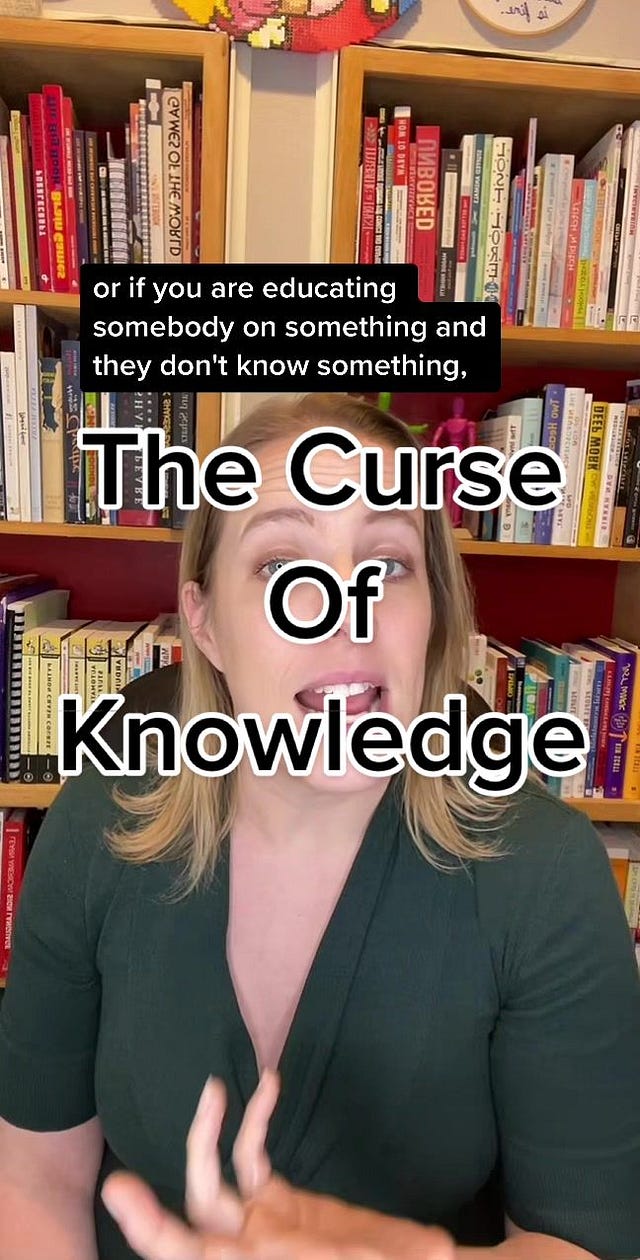Hey!
I came across this TikTok some time ago and then forgot about it.
I mean, I didn’t even ‘double-tap’ it
Then I found myself clapping to my own ‘birthday song’ and had to go dig it out.
What’s obvious to me may not be obvious to you, that’s my curse of knowledge.
The curse can make us forget that others don’t know as much - or care as much - about things that matter to us.
Living under the curse has damaging consequences.
It can turn you into a know-it-all asshat in everyday interactions.
And it gets worse if you’re a marketer.
Because the majority of your revenue comes from people who don’t know and don’t care about your brand.
And forgetting or not caring about them is bad for business.
That’s why the third principle of advertising effectiveness, after setting clear campaign objectives and spending more than your market share, is all about:
Reach all buyers and non-buyers in your category.
For millennia brands have been trying to grab our attention.
Whether it’s the Medicis branding themselves and their friends as Italy’s leaders in expensive frescos…
Or this 👇 engraved on the streets of Pompeii directing people to the establishment.
The rules of growth are straightforward:
Drive more light buyers to your brand or
Get the same buyers to buy more often.
As this study of 2,205 FMCG brands shows: brands that acquire new customers grow, while those that don’t shrink.
Building reach doesn’t mean advertising to everyone.
Effective Reach is a combination of two things:
Exposure: ensuring that everyone in your target audience regardless of whether they’re buyers or non-buyers is exposed to your ad.
Frequency: people exposed to the ad see it enough times for the ad to be effective.
I often start by segmenting my audience.
Target Audience includes both buyers and non-buyers of your brand in your category. Pick media to reach everyone in your category at least once.
Strategic Segment includes people among your target audience who are important for your brand position. Design your messaging for this segment. It may be the same as your Target Audience.
In-Market audience is anyone in the target audience that’s the closest to the purchase occasion. Your advertising needs to budget them towards the brand.
You need to create and keep creating future demand.
People buy the idea of buying your brand before they open their wallets.
James Hurman calls it ‘future demand’.
Performance marketers call it Demand Generation and among the bro marketing community, it’s now known as Revenue Engineering.
Take your pick as long as you’re becoming top-of-mind for people who will enter your category in the future, you’re on the right track.
Here’s why you need to create and keep creating future demand.
Categories grow by attracting more users
And as categories grow the brands within them grow as well.
And since categories grow faster than any single brand in them, how much your brand will grow depends on your ability to reach and convince new customers.
This happens because:
Most people buy more brands than one in a category (aka repertoire buying is the norm), and very few people are 100% loyal to a specific brand. Over an extended period, split loyalties reduce repeat purchases from one brand and contribute to growth for other brands.
Brand penetration (% of people who buy your brand) remains constant, with the same customers switching between different brands, as long as the category remains unchanged.
Brands grow by reaching and convincing NEW customers as they enter the category.
And brands with a broader reach have an advantage over brands that don’t, because:
Brands with less market share have far fewer buyers (first jeopardy), and these buyers are slightly less brand loyal (second jeopardy).
Prof. Byron Sharp calls it Double Jeopardy.
Since most people are repertoire buyers and brand penetration remains relatively steady, brands that reach more people in the category grow faster than brands that don’t.
And it’s proven to work in multiple markets and categories.
Reaching everyone in your category builds Mental Availability.
Availability Bias is a powerful tool because people don’t like trying new things.
Change creates cognitive load, so instead, we stick to information that comes to mind easily.
In advertising, we call it Salience or Mental Availability.
And making it easier for people to recognise and remember your brand makes it that much more likely to be picked and placed in the shopping cart.
Big brands are big because they’re recognised by a lot of people.
And that’s what keeps them top of mind – and keeps them growing.
Oh, and one more thing.
I don’t know who needs to hear this, but it needs to be said.
Reach is not a campaign objective or a KPI.
Of course, your ads need to be seen for them to have any effect whatsoever.
How much of your target audience you’re able to reach, and how often, is essential to you reaching your campaign objective.
It is not THE objective.
Since reach is one of the criteria of campaign planning, it’s often confused as a KPI.
Both Reach and Frequency are principles for planning an effective campaign. Neither is the reason you plan a campaign.
Using them as KPIs is the same as saying that the objective of your campaign is to buy media.
You can tell that I’m triggered by this. I so am. So, thank you for coming to my TedTalk 😁
Have the best day!
Aliyar
P.S. After sending the email about ESOV last week, I realised that it was lacking. No example calculation and no notes on how I use it? That just won’t do. So, I’ve updated it now 👇














